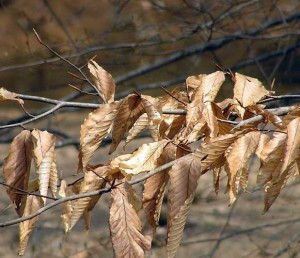Begin 2010 enjoying winter’s beauty
By Ken Moore
How well I remember one winter walk, stopped in mid-stride by the sounds of snow falling through the bare forest canopy. That sound of snow touching the earth remains audible in my recollections.
Driving back from Raleigh on I-40 recently, my companion remarked on the beauty of the winter landscape, particularly noting the magical effect of shining copper-colored leaves on trees in the forest racing by us.
In spite of the cold, I cherish the winter fields for their remarkable colors: browns, burgundy and contrasting off-whites, and the mixture of textures of fluffy seed heads and starkly bare branches.
The forest, shorn of its green leafy canopy, is filled with low-angled light inviting the woods walker to proceed from room to room, taking in particular furnishings most often hidden by lush summer foliage.
The lay of the land is easily visible across the open forest floor, dramatic ups and downs with old erosion gullies crisscrossing everywhere. Here and there the path sometimes intersects animal trails. I can never resist taking off on one of these little trails in the hope that I’ll discover the critter at the end, but each time the animal seems to have disappeared with nary a trace. However, off the beaten path, I always find some botanical or other natural feature of interest.
In the winter, the true architectural characteristics of trees are revealed, with the dramatic skyward stretching of massive limbs. In addition, the amazing diversity of bark surfaces becomes apparent.
One of my favorite trees is the persimmon. They may be detected scattered in open fields and throughout forests by dramatic horizontal angled limbs. The bark is dark and deeply fissured into chunks that make me imagine alligator hide.
Some folks discover that trees are easier to identify when they are in the bare winter condition. For those interested in winter identification, it’s easy to begin with the pocket-sized Winter Tree Finder by May Watts. This guide focuses your eyes and attention on details that are quite obvious once you take the time for a closer look.
In addition to bark color and texture, look for alternate and opposite arrangements of twigs, and notice the shapes of the buds. A smooth light-colored bark is possibly an American beech. If you see alternately arranged copper-colored leaves still hanging on and really slender, sharp pointed buds at the branch tips, you know for certain you have an American beech tree.
If you find a light-colored, smooth-textured bark and the trunk has vertical muscle-like ridges, and you are down along a creek edge, you have an ironwood tree; it’s called blue beech in the northern states. It will not have copper-colored leaves present.
But you don’t have to identify a tree to enjoy it. Just being aware of so many different kinds of trees is worthwhile. And once in awhile, you may want to hug a special tree, and thank it for making possible our life here.
Go take a walk and meet a tree on New Year’s Day. Then make a wish that you’ll do it once a week the rest of the year. Then make that wish come true!




Comments are closed.